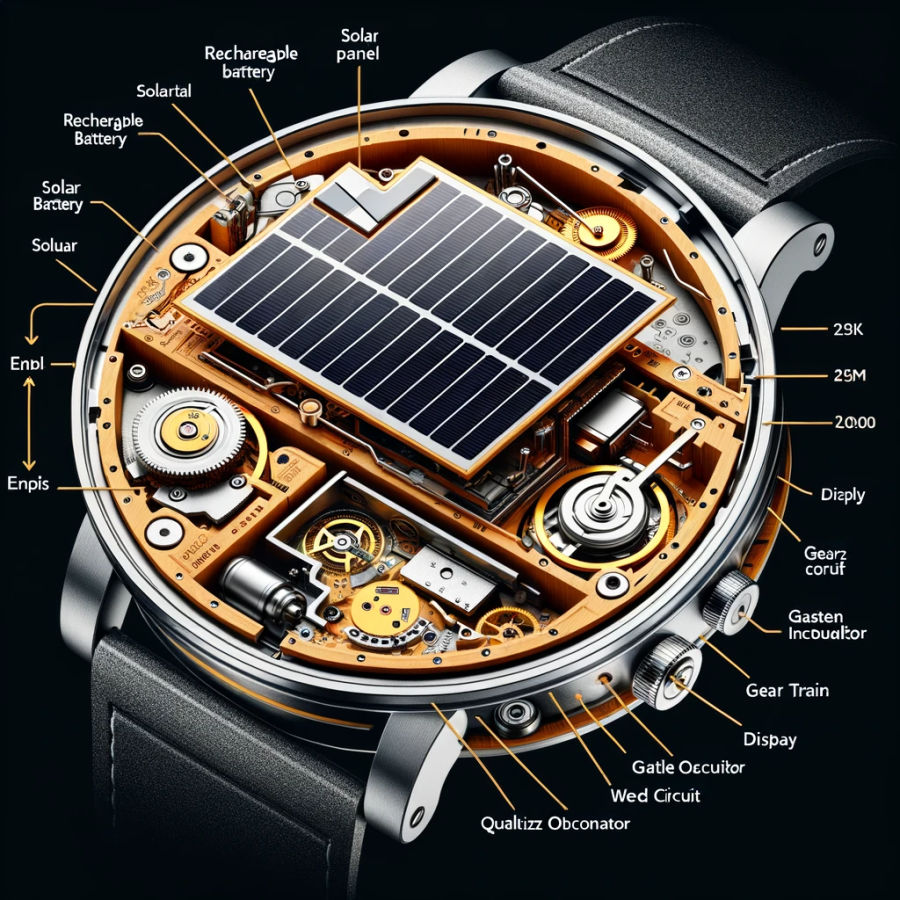How Do Solar Watches Work?
Solar watches are an innovative way to keep time that are gaining popularity among watch enthusiasts worldwide. But, have you ever wondered how do solar watches work? In this section, we’ll explore the fascinating mechanics behind solar watches and the technology that drives them.
Solar watch technology has been around since the 1970s, but it wasn’t until recent years that it became more popular. Solar power is an excellent alternative to traditional batteries used in watches and offers endless benefits.
Let’s dive into the details of how these watches work and what makes them a great investment for anyone looking for a sustainable and reliable timepiece.

The Solar Watch Mechanism
At the heart of every solar watch is a complex mechanism that enables it to harness the power of the sun and keep accurate time. Let’s take a closer look at the components that make up a solar watch and how they work together to deliver reliable timekeeping.
The Solar Panel
The solar panel is the most critical component of a solar watch. It’s usually located beneath the watch face and is designed to absorb sunlight and convert it into electrical energy. The solar panel is usually made of a thin layer of silicon, which contains negatively charged electrons. As sunlight hits the silicon, it knocks these electrons loose, creating an electric current that powers the watch.
The Rechargeable Battery
Once the solar panel has converted sunlight into electrical energy, this energy is stored in the watch’s rechargeable battery. The battery serves as a power source for the watch when there is no sunlight available. The battery is typically made of lithium-ion and can store energy for long periods, ensuring the watch can continue functioning even in low-light conditions.
The Circuit Board
The circuit board is responsible for regulating the flow of electricity within the watch. It controls the various functions of the watch, such as the display, alarm, and other features. The circuit board makes sure that the watch receives just the right amount of energy from the battery and solar panel, ensuring reliable and accurate timekeeping.

The Quartz Movement
The quartz movement is used in most solar watches and is responsible for keeping time accurately. The movement consists of a quartz crystal that vibrates at a specific frequency when an electric current passes through it. The circuit board sends a small electric current to the quartz movement, which then keeps time by vibrating at a precise frequency.
Solar Watch Features
Solar watches offer various features that distinguish them from traditional watches. Many of them have a power reserve indicator that shows how much energy is left in the battery. Some even have eco-friendly features like automatic power-saving modes, which reduce energy consumption when the watch is not in use. Others feature water-resistant designs, making them suitable for use in various outdoor activities.
Overall, the intricate mechanism inside a solar watch offers numerous benefits, including long-lasting power, reduced environmental impact, and reliable timekeeping.
Solar Watch Technology
In solar watches, advanced technology enables accurate timekeeping while harnessing the power of the sun. Let’s take a closer look at the technology behind solar watches.
The Solar Watch Movement
Solar watches operate using a quartz movement, which relies on a small quartz crystal to vibrate and keep time. The movement is powered by a rechargeable battery, which is replenished by solar energy. This type of movement ensures precise timekeeping and long-lasting power.
Solar Watch Features
Solar watches offer a range of innovative features that set them apart from traditional watches. One significant feature is the power reserve indicator, which allows wearers to monitor the amount of stored energy in the watch. Additionally, solar watches often feature energy-efficient designs and materials, making them an eco-friendly choice.
Solar Watch Technology Advancements
The technology of solar watches is constantly advancing and improving. One area of advancement is in solar panels, with manufacturers developing more efficient panels that can generate more power from less sunlight. Another area of development is in energy storage systems, which allow for longer-lasting power reserves and more reliable timekeeping.
Overall, solar watch technology combines accurate timekeeping with eco-friendly design and innovative features. With advancements in solar panel and energy storage technology, the future looks bright for solar powered watches.
Harnessing Solar Energy
In this section, we’ll explore how solar watches harness the power of the sun to function. Solar watches are equipped with a solar panel, which absorbs sunlight and converts it into electrical energy through the photovoltaic effect. This electrical energy is then stored in the watch’s rechargeable battery, which powers the watch’s movement and other functions.
Solar watches can be charged through both natural and artificial light sources. Natural light sources, such as sunlight, are the most efficient way to charge a solar watch. However, artificial light sources, such as incandescent or fluorescent light bulbs, can also be used to charge a solar watch, although it may take longer to achieve a full charge.
One of the key advantages of using solar power in watches is the long-lasting power reserve. Unlike traditional watches that require regular battery replacements, solar watches can run for months or even years on a single charge, depending on the model and usage. This not only saves time and money on battery replacements, but it also reduces the environmental impact of discarded batteries.
Solar Energy Watches vs Traditional Watches
Overall, solar watches offer a sustainable and convenient alternative to traditional watches that require frequent battery replacements. With their advanced technology and long-lasting power reserve, solar watches are poised to become increasingly popular in the future of timekeeping.

Charging and Power Reserve
In the world of solar watches, charging is an effortless process. The sun’s rays or any other artificial light source can power the watch and ensure it stays accurate for long periods. Usually, a solar watch’s charging time takes as little as 5-6 hours to reach full power. Some of the higher-end solar watches even have a power reserve that can last up to six months on a full charge.
When it comes to power reserve on solar watches, it is essential to note that it varies between models. Generally, the level of power reserve depends on the features and functions of the watch. For instance, a solar watch with additional features like a chronograph, alarms, or multiple time zones would require more power to function. As such, the power reserve on such watches might be lower than a standard solar watch.
Solar Watch Functions
Solar watches come with an array of features that make them not only accurate but also versatile. These features include:
- Multiple time zones: Solar watches with this function allow you to set your watch to multiple time zones, making it ideal for world travelers.
- Chronograph: With a stopwatch function, you can time your runs, bike rides, or other activities with precision.
- Calendar: Solar watches often come with a date display and a perpetual calendar, making it easy to keep track of dates and avoid any confusion.
- Alarms: Solar watches have an alarm function that can be set for various timing requirements.
- Power reserve indicator: This function allows you to keep an eye on the watch’s power reserve and charge it when needed.
Solar Watch Features
Aside from the functions, solar watches also come with innovative features that set them apart from traditional watches. Some of these features include:
- Water resistance: Solar watches can withstand water immersion and are perfect for swimming, diving, or water sports.
- Scratch resistance: Solar watches often come with sapphire crystal glass that makes them highly resistant to scratches and damage.
- Durability: With high-quality materials like stainless steel, titanium, or ceramic, solar watches are durable and can last for years, making them a great investment.
- Lightweight design: The advanced technology used in solar watches makes them lighter than traditional watches, making them comfortable to wear all day.
- Sustainable: The use of solar power in watches reduces their impact on the environment by eliminating the need for batteries and reducing waste.
Overall, solar watches are a perfect blend of style, innovation, and functionality. With a wide array of features and functions, these watches are not only reliable but also highly versatile. Additionally, with their sustainable design, they are an excellent choice for anyone looking to make a meaningful impact on the environment.
The Future of Solar Watches
As solar watch technology continues to advance, the future looks bright for these sustainable timepieces.
One potential area of development is in the design of more efficient and effective solar panels. These panels could capture even more energy from the sun, allowing watches to charge faster and retain power for longer periods.
Advances in Energy Storage
Another area of focus is in the development of better energy storage systems. By incorporating new materials and technologies, solar watches could store more energy in smaller spaces, leading to sleeker and more functional designs.
As consumers become more environmentally conscious, the demand for solar powered watches is also expected to grow. This shift in consumer preferences could lead to even more innovation in the field of solar watch technology.

FAQ
How do solar watches work?
Solar watches work by harnessing the power of the sun to generate energy. They have solar panels on their dials that convert sunlight into electrical energy, which is then stored in a rechargeable battery. This energy powers the watch’s movement, allowing it to keep time.
What is the mechanism inside a solar watch?
The mechanism inside a solar watch consists of several components. It includes the solar panel, which captures sunlight and converts it into electrical energy. There is also a rechargeable battery that stores this energy. The battery powers the watch’s movement, which drives the hands and keeps accurate time.
What technology is used in solar watches?
Solar watches utilize advanced technology to ensure accurate timekeeping and efficient use of solar power. They feature solar watch movements that convert electrical energy into rotational energy, driving the gears and hands of the watch. Additionally, solar watches often include features like power reserve indicators and energy-efficient designs.
How do solar watches harness solar energy?
Solar watches harness solar energy through their solar panels. These panels are typically made of photovoltaic cells that convert sunlight into electrical energy. The energy is then stored in the watch’s rechargeable battery, allowing the watch to function even when there is no direct sunlight. This makes solar watches a sustainable and eco-friendly choice.
How do you charge a solar watch?
Solar watches can be charged through both natural and artificial light sources. Simply expose the watch’s solar panel to light, and it will convert the sunlight into electrical energy to charge the battery. The watch can also be charged using artificial light, such as indoor lighting. This ensures that the watch remains powered and ready to keep time.
How long does the power reserve of a solar watch last?
The power reserve of a solar watch can vary depending on the model and the amount of light it receives. In ideal conditions, some solar watches can last for several months with a fully charged battery. However, even in low-light conditions, solar watches have a power reserve that allows them to continue functioning. This ensures reliable timekeeping at all times.
What does the future hold for solar watches?
The future of solar watches looks promising. As technology continues to advance, we can expect improvements in solar watch technology. This may include more efficient solar panels that can generate more energy from sunlight, as well as better energy storage systems. Solar powered watches are also gaining popularity as people become more conscious of sustainability and seek eco-friendly timekeeping solutions.

Alan Dale is an experienced backpacker and adventure sports athlete who pays the bills by writing. Married with a small brood, Alan often has his kids in tow on many of his adventures. You can visit Alan here: https://siralandale.com/




